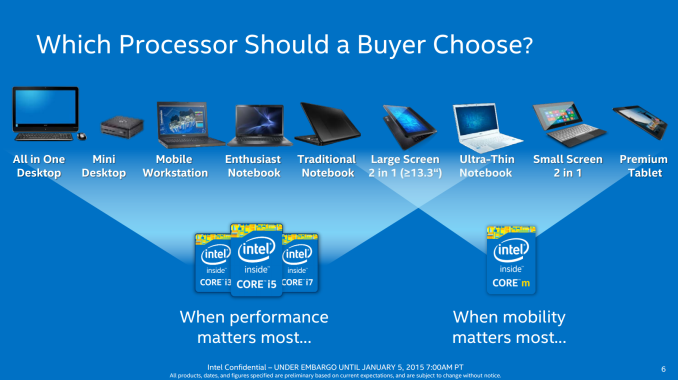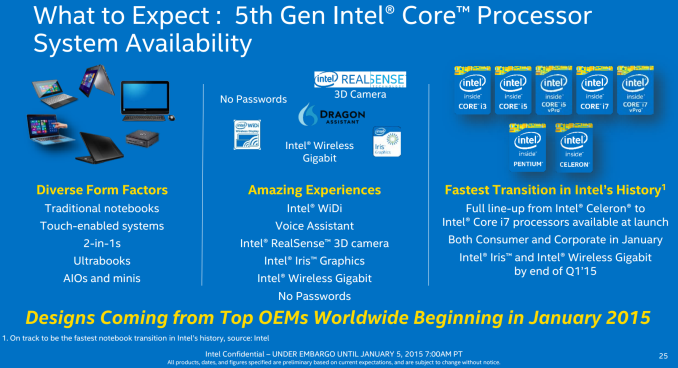Intel Releases Broadwell-U: New SKUs, up to 48 EUs and Iris 6100
by Ian Cutress on January 5, 2015 10:00 AM ESTFitting in With Core M
The staggered release of Broadwell is nothing new. Previous releases from Intel has seen them pick a particular market and aim at that first, whether it be tablet, mobile devices, ultrabooks or desktops, with the rest to follow. Core M, Intel’s 4.5 W ‘Broadwell-Y’ part, has been in the market for over a month with designs such as the Lenovo Yoga 3 Pro, although the number of SKUs available as well as worldwide distribution has been relatively slow, with the designs featuring Core M being expensive in terms of casual computing and more premium upgrades. Broadwell-U changes this by opening up the power envelope, and as such Intel sees the market at follows:
The Broadwell-U processors from Intel are aiming to give enough performance from AIO desktop systems to mini desktops, premium mobile applications all through to large 2-in-1s. There is some overlap with Core M, particularly with the 7.5W cTDP down elements of the range, but the interesting element will be pricing. The Celerons come in around $100, with the Pentium at $160, but then it gets expensive for Broadwell-U. $275 to $315 covers all the i3 and i5 parts both at 15W and 28W, ending with $393/$426 for the i7 parts. Further to my efficiency comments above, on paper at least the i5-5350U or i5-5250U would seem the most interesting processors of the bunch.
Release Dates
In our conference call with Intel, it was clear that these CPUs are shipping to their partners today. Throughout CES there will be a number of manufacturers announcing their products, and as per the norm Intel allows the partners to introduce their own products, rather than showing examples of where Broadwell-U fits in. However, because Broadwell-U is designed to be pin-compatible with Haswell-U, we might see some manufacturers purely re-releasing some of their designs with the newer CPU and a firmware update. Nevertheless, Intel is expecting OEM systems with Broadwell-U to start shipping in North America within the month. Designs with Iris graphics, or those featuring Intel based WiGig connectivity, will be more towards the end of Q1. Overall Intel is tracking ‘hundreds of designs’ involving Broadwell, indicating that it will be a significant push to bring 14nm to the market.












85 Comments
View All Comments
Jaybus - Monday, January 5, 2015 - link
Huh? Peak FP32 for x1 is 512 GFlops, substantially less than 48 EU Broadwell-U.name99 - Tuesday, January 6, 2015 - link
BUT Intel offer a coherent single address space for GPU and CPU compute. This is an important step on the path to practical commonplace heterogeneous computing. As far as I know nV aren't offering that in X1.(I'd be curious to know if Imagination are offering it in Rogue 7, because Apple are probably the company that's best set to put all the pieces of this together, from the hardware through the OS to the language+dev tools to the frameworks' but if IMG aren't on track, Apple are kinda screwed. Of course Apple COULD be preparing their mythical self-designed GPU...)
There's plenty to be irritated about with Broadwell, but let's praise the improvements that really are a good foundation for the future, and this is primary among them.
stephenbrooks - Tuesday, January 6, 2015 - link
GFlops not TFlops! And at FP32 the Tegra X1 peaks at 512 Gflops (source: http://anandtech.com/show/8811/nvidia-tegra-x1-pre... ).tipoo - Sunday, January 18, 2015 - link
*Twitch*Argh. The X1 gflop number you just gave is for half precision, it's their double speed FP16 mode. And then you're going and comparing that to a full precision number.
MattCoz - Monday, January 5, 2015 - link
I'm really interested to see what kind of performance improvement can be seen over my current Ivy Bridge i5-3317U. I really want to upgrade my laptop for numerous reasons, but after 2 years I'm looking for more than just a marginal increase in performance. I was very disappointed when Lenovo went with the Core M for the Yoga 3.TiGr1982 - Monday, January 5, 2015 - link
I have this same Core i5-3317U in Surface Pro 1 (1st gen, it works without throttling there, but two CPU fans are audible under heavy load). I believe, CPU-wise, you won't get really big improvements with Broadwell-U over Ivy-U. GPU-wise, however, Broadwell-U will be way faster.So, it depends on what you are interested in more: CPU progress, GPU progress, or both.
III-V - Monday, January 5, 2015 - link
I'm in the same boat. Think I have the same processor, too.I am looking at getting the inevitable Surface Pro 4. It looks like I'll be able to get the same CPU performance (assuming it's Broadwell-Y), and a fair bit better GPU performance, with much improved battery life. Should be good for my needs... Don't need too much number crunching power on the thing, and the graphics are a real sore spot on my Asus S400CA.
nwarawa - Monday, January 5, 2015 - link
I am concerned about the Broadwell Pentiums and Celerons overlapping with the new Cherry Trail.Up until now, Baytrail and Ivybridge Celerons have been sold in similarly priced systems. The Celeron might use a bit more power, but in a cheap laptop, or especially a little ITX box, it was worth it for the extra performance. The 1.5 IvyBridge cores still hold a noticeable lead over a Baytrail core at 2.6 (boost). They shared the same GPU generation, but the Celeron had 6 EUs to the Baytrail's 4 EUs, plus ran at a higher clock.
Now, apparently CherryTrail is going to have 16 EUs to Broadwell Celeron's 12 EUs. They both will have dual-channel LPDDR3-1600 interfaces, so unless the GT1 is clocked significantly higher, this will be the first time an Atom has a better GPU than its mainstream contemporary.
As for the CPU portion, for years the cheapest Celeron U has hardly budged in clockrate, from the 1.4 Sandybridge to the new 1.5 Broadwell. So these chips' upgrades have depended almost entirely on process improvements. The process improvements from BayTrail to CherryTrail sound a bit more aggressive than those from Haswell to Broadwell. So, if Intel ends up clocking the CherryTrail higher too (say, 2.8boost), we may also have situation were the CherryTrail has near CPU performance parity with the Broadwell Celeron.
naloj - Monday, January 5, 2015 - link
Looks like Intel has published the specs of the Broadwell-U NUC line:http://www.intel.com/content/www/us/en/nuc/product...
ayejay_nz - Monday, January 5, 2015 - link
Thanks a lot for this link!